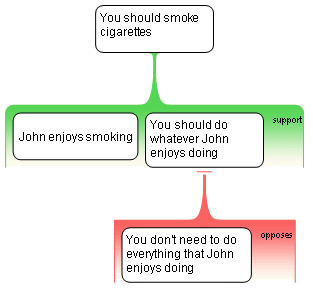The Science Of Scientific Writing Set 9 Set 9-Analysis maps • Second page • Example • Exercise 1 • Exercise 2 • Exercise 3 • Exercise 4 • Exercise 5 • Refinement Revisited • Rabbit Rule • Holding Hands Rule • Exercise 6 • Inference objections • Exercise 7 • Exercise 8 • Final.
OVERVIEW: The way to well-written science
PART I: Paragraphs and Sentences
SET A: Paragraphs: The Maps Behind Them
SET B: Paragraphs: Using Maps to Meet Readers' Expectations
SET C: Paragraph Coherence and Cohesion
SET D: Sentences
SET E: Scientific Sections (including Methods)
SET F: Scientific Sections: The Discussion
SET G : Scientific Sections: The Introduction
SET H : The Paper as a Whole
Here's a portion of the smoking map from Set 7:

When we evaluated this we decided that what John enjoys isn't relevant for deciding what you should do, especially if he enjoys doing something silly or dangerous. Think about this for a minute: we didn't reject the claim that John enjoys smoking - we decided that it was irrelevant for deciding what you should do. What we actually rejected was an unstated assumption: you should do whatever John enjoys doing.
That assumption can be brought into the open using an Analysis map:

This map is more precise because it breaks down the reason into multiple claims, which are called 'premises'. These claims aren't two separate reasons - they work together as part of a single reason.
Content of this page drawn in whole or part from the Austhink Rationale Exercises with permission from Austhink.